Looking at a white budgie, you might feel like you’ve stumbled across a rare gem.
Their gleaming white feathers glisten like fresh snowfall, a spectacle of avian beauty.
Having been a budgie owner myself, I have a special spot in my heart for these little creatures.
And as a former veterinary worker with experience in Texas, London, and Istanbul, I’ve come across a fair number of them.
So, let’s delve into the captivating world of white budgies, exploring their unique mutations, how to produce them, and everything in between.
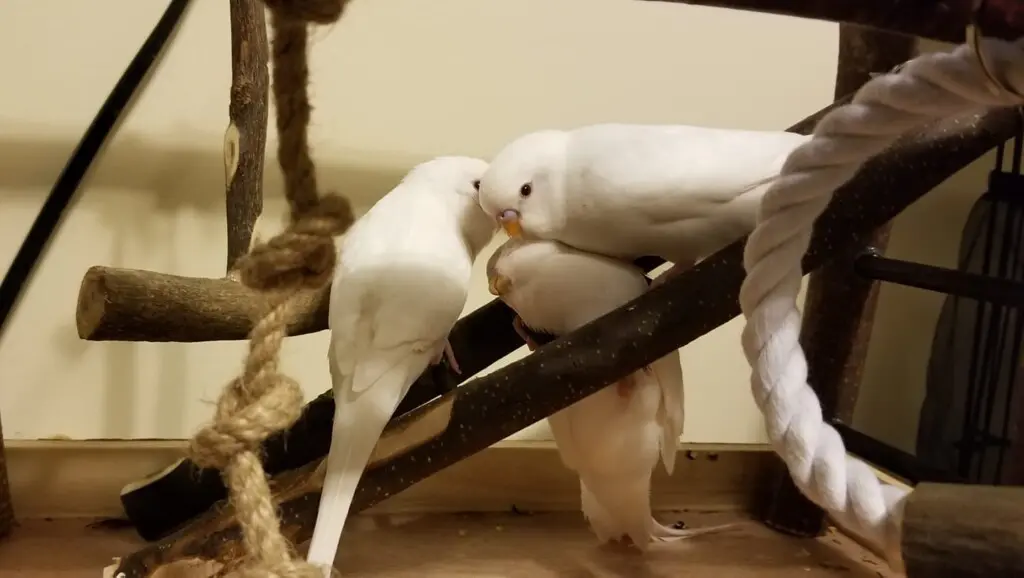
What Is A White Budgie?
A white budgie, as one might infer, is a budgerigar that sports a white plumage.
But there’s more to it than just the color.
When we say ‘white budgie,’ we’re not just talking about a bird with white feathers; we’re referring to a few specific genetic mutations that result in the budgie’s white appearance.
A white budgie could belong to one of several mutation types, including the Albino, Dark Eyed Clear, or DF Spangle.
Each of these mutations is unique and imparts the budgie with its snowy exterior.
Albinos, for instance, are completely devoid of melanin, the pigment responsible for color in a budgie’s feathers.
Dark Eyed Clears are an interesting blend of the Clearflight Pied and the Recessive Pied mutations.
Meanwhile, the DF Spangle mutation is a bit more complex, resulting from the double factor spangle gene.
To the untrained eye, all white budgies may look alike.
However, discerning between these mutations can be quite intricate, involving the examination of various factors beyond color, such as the bird’s eyes, beak, and cere.
But despite these complexities, one fact remains unequivocal – white budgies, in all their diverse forms, are stunning to behold.
Their serene coloration is a beautiful sight, making them a cherished pet for many bird enthusiasts around the world.
How Can I Tell If My Budgie Is A White Budgie?
Determining whether your budgie is a white budgie involves a bit more than simply observing its color.
While the primary characteristic is indeed the predominantly white plumage, the intricacies of budgie mutations require us to consider other physical traits as well.
Here’s a quick guide on how to ascertain if your budgie is a white budgie:
- Examine the Feather Color: As mentioned earlier, white budgies have predominantly white plumage. If your budgie appears mostly white, it could potentially be a white budgie. Remember, this is only a first step, and other characteristics must also be considered.
- Look at the Eye Color: The eye color can provide clues about the specific mutation your white budgie may belong to. For instance, Albino budgies typically have red eyes due to the absence of melanin. On the other hand, Dark Eyed Clear budgies, as their name suggests, have dark eyes.
- Observe the Cere: The cere, the area above the beak housing the nostrils, can also provide hints about your budgie’s mutation. For instance, albino budgies often have pink or purplish ceres, while other mutations may have slightly different coloration.
- Study Any Markings or Patterns: Though white budgies are predominantly white; they may carry subtle markings or patterns depending on their specific mutation. For instance, DF Spangle budgies could exhibit faint wing markings, adding an extra layer of detail to their identification.
Budgie Mutations (Types) That Can Have A Whole Body White?
In the world of budgies, genetic mutations can result in a breathtaking array of colors and patterns.
Among these, there are specific mutations that can result in a budgie showcasing a white body, making them particularly captivating.
Here, we’ll delve into three primary budgie mutations responsible for their dazzling white appearance – Albino, Dark Eyed Clear, and Double Factor Spangle (DF Spangle).
- Albino Budgies: Albinos are perhaps the most well-known white budgie mutation. They are characterized by their complete lack of color pigmentation, not just in their feathers, but across their entire body, including their eyes and skin. As a result, albino budgies are pure white with red or pinkish eyes. They belong to the blue series of budgie mutations, and their coloration (or lack thereof) is a result of the absence of melanin pigment.
- Dark Eyed Clear Budgies: Dark Eyed Clear budgies are an interesting combination of two budgie mutations – Clearflight Pied and Recessive Pied. They carry traits from both these mutations, resulting in a budgie with white or yellow plumage, devoid of any markings or patches of color. As the name implies, they have dark eyes, unlike the red or pinkish eyes seen in albino budgies.
- Double Factor Spangle Budgies (DF Spangle): The Spangle mutation in budgies results in a bird with a distinctive wing pattern where the normal coloration is reversed – the areas that would typically be colored are white or yellow, and the areas that would be white are colored. In a Double Factor Spangle budgie, this effect is amplified, leading to a budgie that is mostly or entirely white or yellow.
In the case of budgies, it’s not just about the color.
These mutations each come with their own unique set of characteristics, making every white budgie a distinctive individual.
Whether it’s an albino budgie with its red eyes and white feathers or a Dark Eyed Clear budgie with its clear eyes and devoid of any markings, white budgies are truly a delight to behold.
Albino Budgie (Most Popular)
Perhaps the most recognized of all the white budgie mutations is the Albino budgie.
Its stark white plumage and striking red or pink eyes are impossible to miss, and these birds stand as some of the most fascinating examples of budgie coloration.
Albino budgies are a result of a genetic condition known as albinism, which leads to a complete absence of the pigment melanin in the bird’s body.
This lack of pigmentation extends not only to the feathers but also to the skin, eyes, and cere.
It is this lack of melanin that gives the albino budgie its unique white plumage and red or pink eyes.
In addition to their stunning looks, albino budgies are much like any other budgie.
They’re playful, intelligent, and can make great pets.
However, albinism in budgies can come with some health considerations.
For instance, albino budgies can be more sensitive to bright light due to the lack of pigmentation in their eyes.
It’s also worth noting that determining the sex of an albino budgie can be a bit trickier than with other budgies.
While in other varieties, males usually have blue ceres and females have brown or whitish ceres, in albinos, both males and females can have pink or purplish ceres.
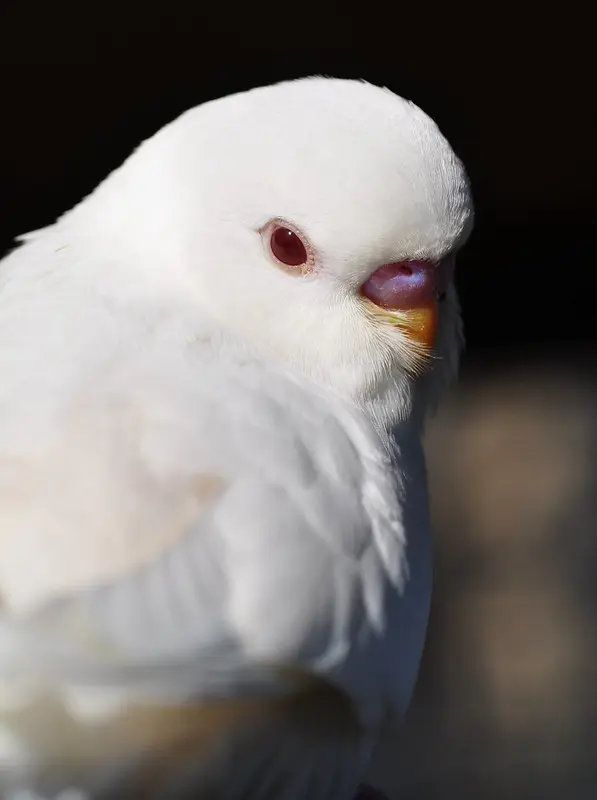
Dark Eyed Clear Budgie
The Dark Eyed Clear budgie is another intriguing white budgie mutation that holds a unique place within the budgie color spectrum.
This mutation occurs when a budgie inherits two specific mutations: Clearflight Pied and Recessive Pied.
When these mutations coincide, the result is a bird devoid of markings and presenting an overall white or yellow hue depending on whether the budgie belongs to the blue or green series respectively.
As the name suggests, Dark Eyed Clear budgies have dark eyes, distinguishing them from their red or pink-eyed Albino counterparts.
Their feathers are uniformly white or yellow with no patches or markings, and they maintain this uniform coloration throughout their life.
The cere of a Dark Eyed Clear budgie follows the usual color indications for sex in budgies.
Males typically have a blue cere, while females have a brown, white, or crusty tan cere.
However, in some cases, the color of the cere can be less pronounced than in budgies of other mutations.
While their appearance is eye-catching, what truly sets Dark Eyed Clear budgies apart is their delightful personalities.
They’re lively, engaging, and intelligent, bringing joy and vibrancy to their surroundings.
They can learn to mimic human speech, whistle tunes, and can be a delightful addition to any home.
In essence, Dark Eyed Clear budgies encapsulate the beauty of budgie mutations, combining a striking visual appearance with an endearing personality, making them a wonderful choice for budgie lovers.
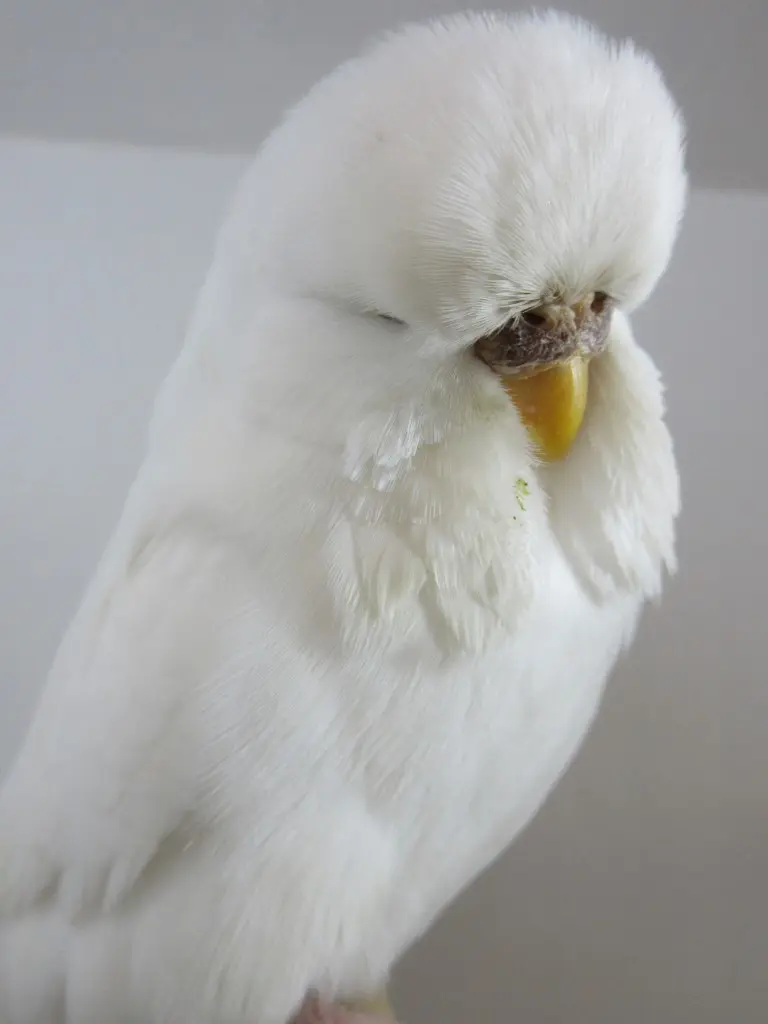
DF Spangle Budgie
The Double Factor Spangle budgie, or DF Spangle, is yet another white budgie mutation, showcasing an enthralling interplay of genetics and coloration.
The Spangle mutation in budgies results in a unique wing pattern, with areas typically white being colored, and areas that are usually colored, being white.
When this mutation is present in double factor form, it amplifies the effect, resulting in a bird that is almost entirely white or yellow.
DF Spangle budgies stand out due to their unique combination of coloration and markings.
While they are predominantly white or yellow, they may still exhibit faint wing markings.
Their eyes are usually dark, and their ceres follow the typical color pattern for gender identification: blue for males and brown, white, or tan for females.
It’s also interesting to note that breeding DF Spangle budgies can result in a mix of Single Factor (SF) Spangle, DF Spangle, and Normal chicks, depending on the genetics of the other parent bird.
This variety makes breeding these budgies an exciting endeavor for breeders.
In a nutshell, a DF Spangle budgie is not just a white bird.
It’s a result of an intriguing genetic dance, creating a budgie that is visually captivating and full of character.
They indeed add a touch of fascination to the already vibrant world of budgies.
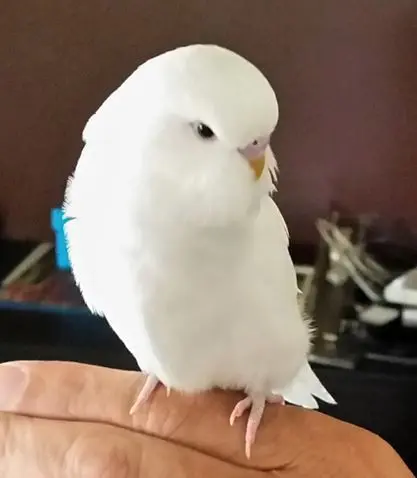
How To Produce A White Budgie?
Breeding a white budgie, like any other specific color or mutation, requires a certain understanding of budgie genetics.
While it’s not an exact science, knowing the parent birds’ genetic makeup can increase the chances of producing a white budgie.
The three mutations primarily responsible for producing white budgies are the Albino, Dark Eyed Clear, and Double Factor Spangle (DF Spangle).
Each of these mutations is genetically distinct, so the process of breeding a white budgie will vary depending on which mutation you’re targeting.
- Albino Budgie: Breeding albino budgies requires both parent birds to carry the ino gene in blue series. This gene is recessive, meaning that the offspring will only be albino if it inherits the albino gene from both parents.
- Dark Eyed Clear Budgie: This mutation is a combination of the Clearflight Pied and Recessive Pied mutations. To produce a Dark Eyed Clear budgie, both parent birds need to carry both these genes. If only one parent carries the required genes, the chicks may still carry the genes but won’t display the Dark Eyed Clear mutation.
- DF Spangle Budgie: To breed a DF Spangle budgie, one or both parent birds need to be Spangle budgies. If both parents are Single Factor (SF) Spangle budgies, there’s a chance that some of the offspring will be DF Spangle. If one parent is a DF Spangle and the other is a SF Spangle or Normal, the chicks could be either SF Spangle or DF Spangle.
Breeding budgies for specific mutations is an intricate process that involves understanding of genetics, careful selection of parent birds, and sometimes a bit of luck.
It’s also worth noting that budgie breeding should only be undertaken responsibly, with due consideration for the wellbeing of the parent birds and the chicks.
Can White Budgies Be Bred With Other Budgies?
Absolutely! White budgies, regardless of their specific mutation, can certainly be bred with other budgies.
However, the resulting offspring’s coloration and mutation will be influenced by the genetics of both parent birds.
When a white budgie, whether it’s an Albino, Dark Eyed Clear, or DF Spangle, is bred with another budgie, several outcomes are possible:
- Breeding with the Same Mutation: If a white budgie is bred with another budgie of the same mutation, the offspring will also carry that mutation. For instance, two Albino budgies will likely produce Albino chicks.
- Breeding with a Different White Mutation: If a white budgie is bred with a budgie of a different white mutation, the resulting offspring’s coloration could be more unpredictable. The chicks may exhibit traits of either parent or potentially be a mix.
- Breeding with a Non-White Budgie: When a white budgie is bred with a non-white budgie, the offspring’s coloration depends on the non-white parent’s genetics. For example, if the non-white budgie carries the necessary recessive genes for the white budgie’s mutation, some of the offspring could exhibit the white mutation.
- Breeding with a Normal Budgie: If a white budgie is bred with a normal (wild type) budgie, the chicks will likely be normal but carry the white mutation gene. These offspring could then potentially produce white budgies if bred with another carrier of the mutation.
What Is The Difference Between White Budgies And Albino Budgies?
In budgie parlance, the term “white budgie” is an umbrella term that encompasses several mutations resulting in a predominantly white feather coloration.
This broad category includes Albino budgies, but also Dark Eyed Clear and Double Factor Spangle (DF Spangle) budgies.
Albino Budgies are a specific type of white budgie.
They exhibit a genetic condition known as albinism, leading to a total absence of melanin across the entire body, including the feathers, skin, and eyes.
This absence of melanin results in a budgie with white plumage and red or pink eyes.
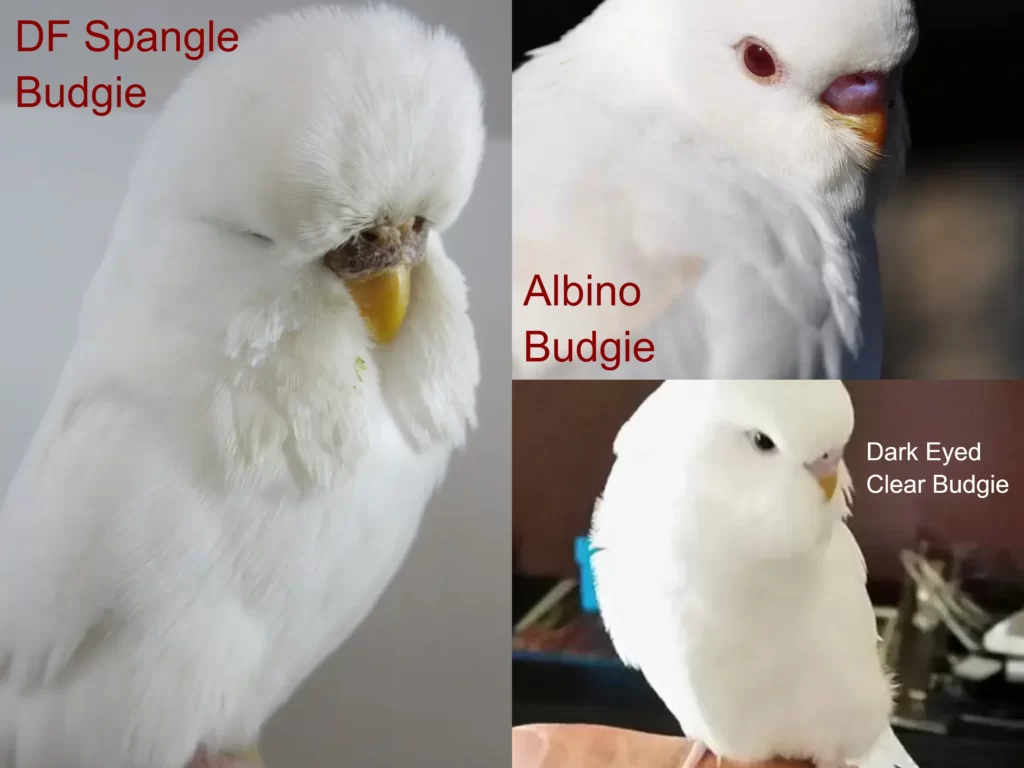
On the other hand, White Budgies, as a larger category, also includes other mutations:
- Dark Eyed Clear Budgies: These birds result from the combination of the Clearflight Pied and Recessive Pied mutations, leading to a budgie that is white or yellow (depending on the base color series), without any markings. They have dark eyes, unlike Albino budgies.
- DF Spangle Budgies: In these birds, a Spangle mutation in double factor form leads to a budgie that is predominantly white or yellow. They may still display faint wing markings and usually have dark eyes.
Thus, while all Albino budgies are white budgies, not all white budgies are Albino.
The crucial difference lies in the specific mutation and resulting features such as eye color, presence or absence of markings, and the cere’s color.
Understanding these nuances is key to identifying and appreciating the diverse world of white budgie mutations.
Does The Color Of The Budgie Affect Behavior, Breeding?
There’s a common question among budgie owners and enthusiasts: does the color of a budgie affect its behavior or breeding capabilities? The short answer is no, not directly.
Budgie behavior is predominantly influenced by factors such as genetics, individual personality, upbringing, environment, and social interaction rather than color.
A budgie’s color or specific mutation doesn’t determine whether it’s going to be more or less active, friendly, vocal, or intelligent.
These traits can vary widely among budgies of the same color, and similarly colored budgies can have vastly different personalities.
When it comes to breeding, color can have an indirect role.
The color of budgies is determined by specific genes, and these genes can influence what color and mutation offspring will have.
However, it doesn’t affect a budgie’s fertility or ability to breed.
A white budgie has the same breeding capabilities as a blue, green, or yellow one.
However, it’s important to note that certain genetic traits, like the Ino gene responsible for the Albino mutation, can sometimes be linked with health considerations.
For instance, some believe that Albino budgies, due to their lack of pigmentation, can be more sensitive to bright light.
But this doesn’t impact their general behavior or breeding capability.
So, while the color and mutation of a budgie can certainly influence its visual appearance and the appearance of its offspring, it doesn’t directly impact the bird’s behavior or ability to breed.
Regardless of color, each budgie is a unique individual with its own character and charm.
Do White Budgies Require Special Care?
White budgies, whether they’re Albinos, Dark Eyed Clears, or Double Factor Spangles, generally require the same level of care as budgies of any other color.
The color of a budgie’s feathers does not significantly impact its health or care requirements.
Like all budgies, white budgies need a balanced diet.
This should primarily consist of high-quality budgie pellets, along with a variety of fresh fruits and vegetables.
Seeds can be offered as a supplement but should not make up the majority of their diet due to their high fat content.
Regular exercise and mental stimulation are also essential for a white budgie’s wellbeing.
A large cage that allows for flight, toys for mental stimulation, and social interaction (either with humans or other budgies) can all contribute to their overall health and happiness.
While white budgies do not generally require specific care due to their color, there are anecdotal reports that Albino budgies, which lack pigment in their eyes, might be more sensitive to bright light.
In such a case, care should be taken to avoid sudden exposure to intense light or sunlight.
Ensuring a clean living environment is also paramount.
Regular cage cleaning helps prevent diseases, and providing fresh water daily is essential.
In terms of health, white budgies, like all budgies, can be prone to certain illnesses.
Regular check-ups with an avian vet can help detect any potential issues early.
Is A White Budgie Always A Boy Or A Girl?
The color of a budgie’s feathers, including white, doesn’t determine its gender.
White budgies can be either males or females.
The most reliable way to determine a budgie’s gender is by observing the color of the cere, the fleshy, bumpy area above the beak where the nostrils are located.
In most budgies, the cere’s color will be a strong indicator of the bird’s sex.
Males usually have a blue cere, while females typically have a brown, white, or tan cere.
However, this can vary depending on the budgie’s age and hormonal state, and certain mutations may also affect the cere color.
For instance, in white budgies like Albinos and Double Factor Spangles, the males often have a pink or purplish cere, while the females’ cere is usually a paler blue or whitish color that can turn brownish when they’re in breeding condition.
It’s also essential to remember that young budgies, regardless of color, have ceres that are a purplish-pink color, making it difficult to determine gender until they reach maturity at around six months.
In conclusion, a white budgie can be either a boy or a girl.
The feather color doesn’t dictate the bird’s sex, and gender identification should be based on the cere color and sometimes behavioral clues, although the former is the most reliable indicator.
Are White Budgies Rare?
The rarity of white budgies largely depends on the specific mutation and the region in which they are found.
Broadly speaking, white budgies are not considered extremely rare, especially in captive breeding programs where various mutations, including those leading to white budgies, are intentionally encouraged.
Among the types of white budgies, Albinos and Double Factor Spangle budgies are relatively common in the pet trade and aviculture due to their striking appearance.
Dark Eyed Clear budgies, while not exceptionally rare, are somewhat less common due to the specific combination of genetic traits necessary to produce this mutation.
In the wild, these mutations are indeed quite rare.
The natural coloration of wild budgerigars in Australia is a combination of green, yellow, and black.
Mutations such as albinism or spangling that lead to white coloration are infrequent in wild populations as they offer little advantage in terms of camouflage and survival.
In breeding and pet markets, the availability of white budgies may vary.
Some breeders specialize in certain mutations, while others might have a more random assortment depending on the parent birds’ genetics.
In conclusion, while white budgies might be uncommon in some areas or specific mutations, they are not typically classified as rare, particularly in captive breeding contexts.
Regardless, their unique beauty makes them a cherished pet for budgie enthusiasts around the globe.
How Is The White Budgie’s Cere?
The cere is the fleshy, bumpy area located at the top of a budgie’s beak, where the nostrils are located.
It is often used to determine a budgie’s sex as it displays color changes based on the bird’s gender, age, and hormonal condition.
However, with white budgies, including Albinos, Dark Eyed Clears, and Double Factor Spangles, the cere’s color can sometimes be different from the standard norms.
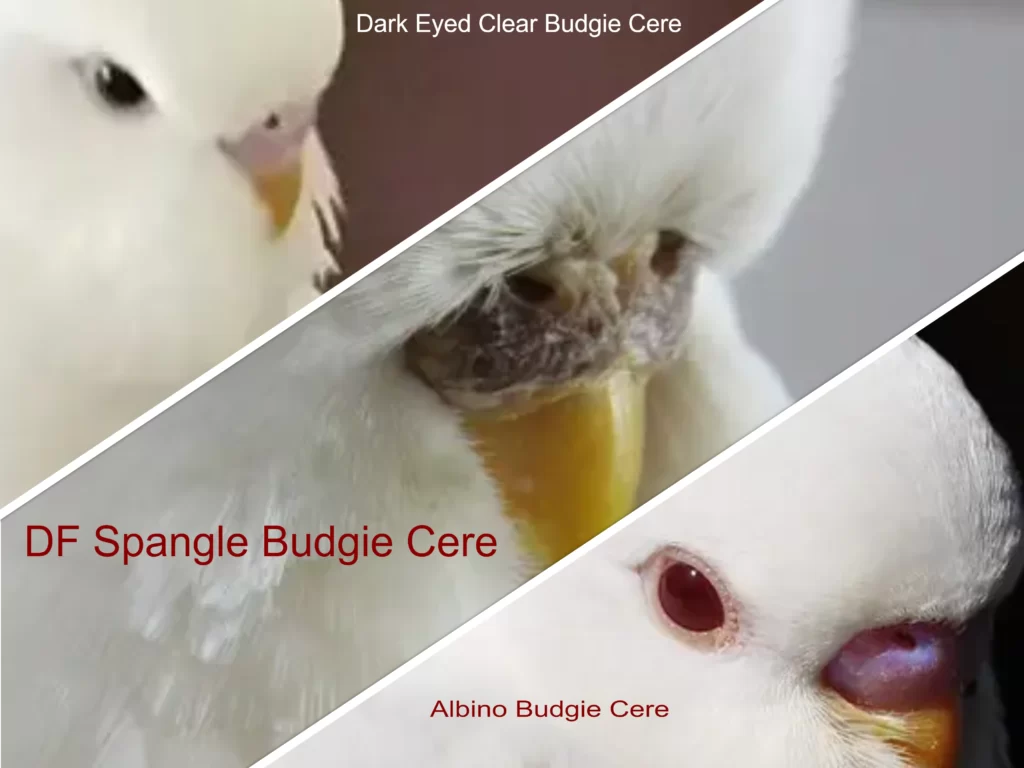
For male white budgies, the cere often appears a shade of pink or purplish-blue, which can be somewhat paler compared to non-white males.
This is especially true for Albino males due to the lack of pigmentation in their bodies.
The cere of male budgies generally stays consistent in color except during illness.
Female white budgies usually have a cere that is pale blue, whitish, or tan, and it can turn a crusty brown when the bird is in breeding condition.
As with males, certain mutations like Albino can lead to a paler cere in females.
Female ceres can fluctuate more widely than males due to hormonal changes.
For young white budgies, it can be challenging to determine the sex because their ceres are typically a uniform purplish-pink, regardless of their eventual gender.
As they mature, usually around six months, the cere will change to reflect their sex.
Budgie Names And Their Meanings Selected For White Budgies
Choosing a name for your white budgie can be a delightful task.
Often, budgie owners opt for names inspired by their pet’s striking coloration.
Here are some ideas, with meanings, for white budgie names:
- Snowy: An obvious choice for a white budgie, this name calls to mind the purity and beauty of a snowfall.
- Ivory: This name suggests the white, elegant beauty of pure ivory and can be ideal for a graceful white budgie.
- Pearl: A precious gem produced by oysters, it’s a fitting name for a precious white budgie.
- Cloud: Just like fluffy, white clouds drifting in a clear blue sky, this name suits a white budgie perfectly.
- Marshmallow: This name is perfect for a white budgie with a soft, fluffy appearance.
- Angel: The name conjures images of divine beings often depicted with white wings.
- Luna: Meaning ‘moon’ in Latin, this name is perfect for a white budgie, reminiscent of the moon glowing softly in the night sky.
- Blanca: This name means ‘white’ in Spanish and could be a unique name for your white budgie.
- Ghost: Ideal for a white budgie, especially around Halloween, this name has a fun and spooky vibe.
- Frost: This name invokes the image of a chilly winter morning when everything is covered in a fine, white frost.
📷 White Budgie Special Photos
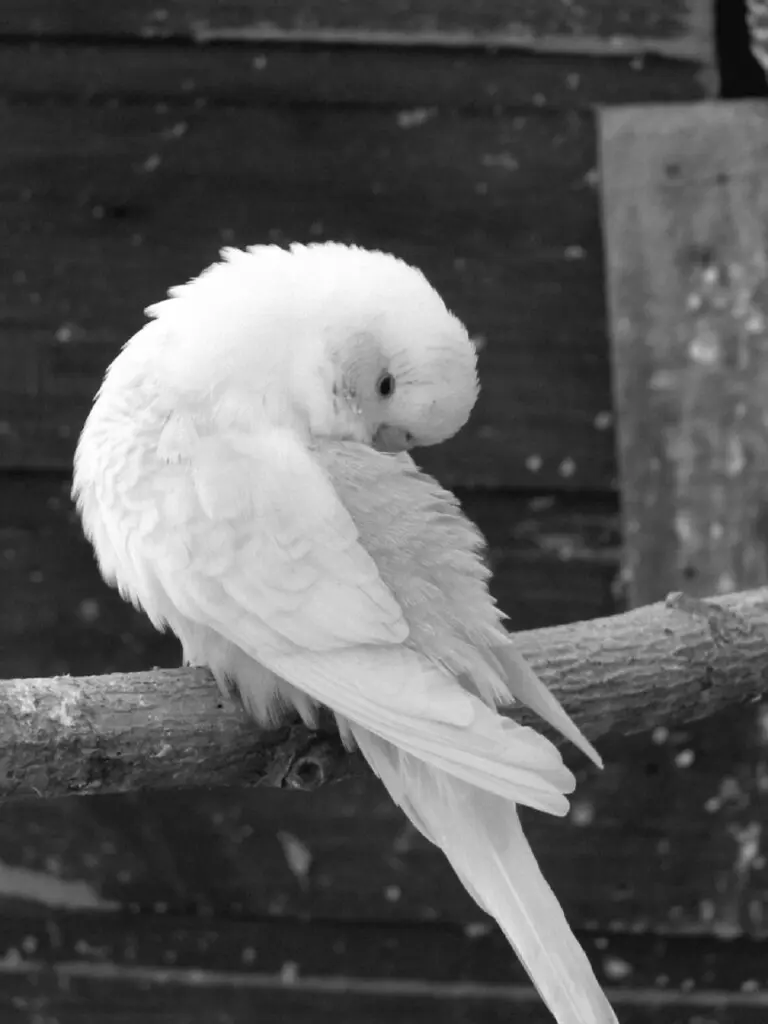
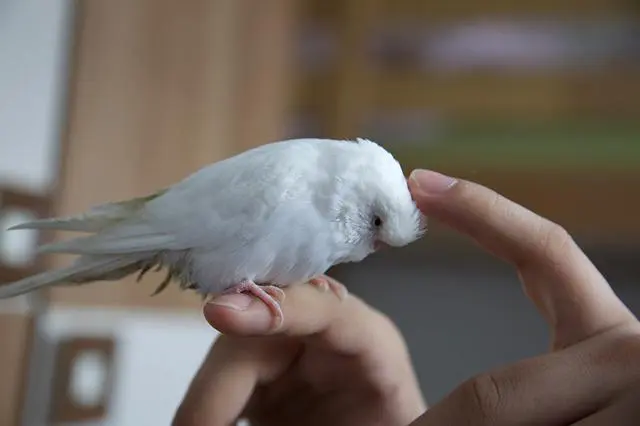
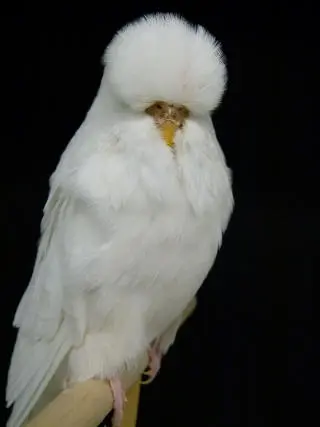
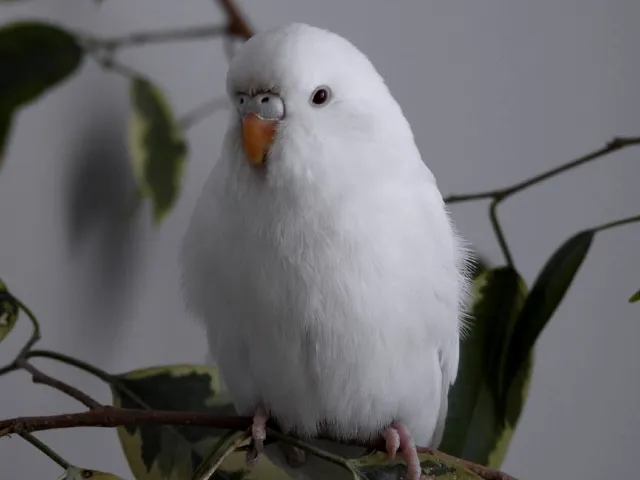
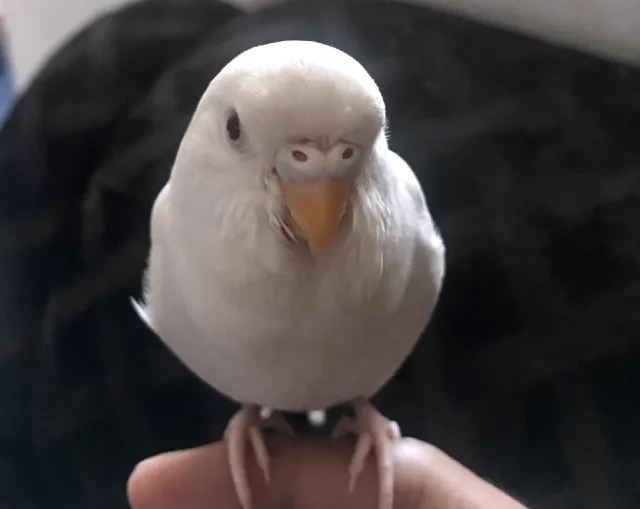
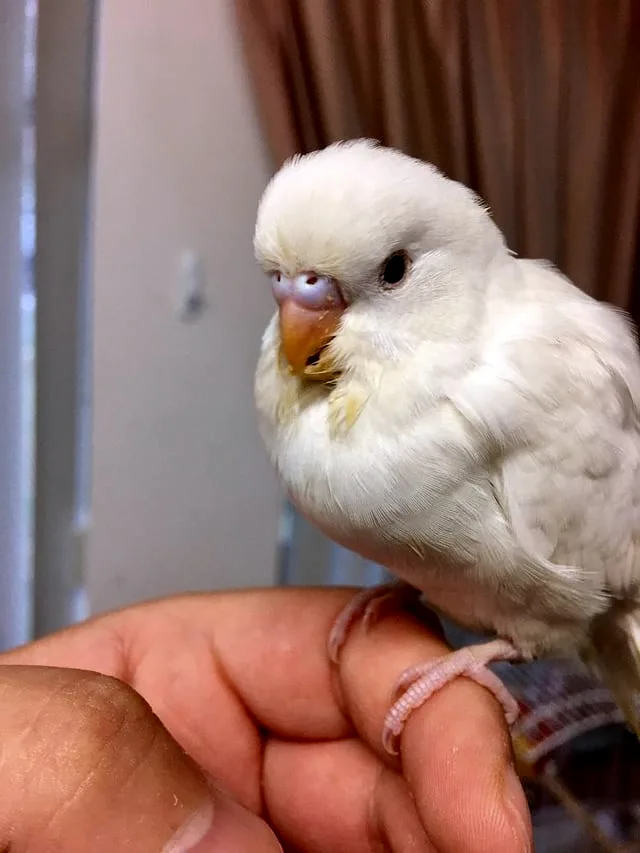
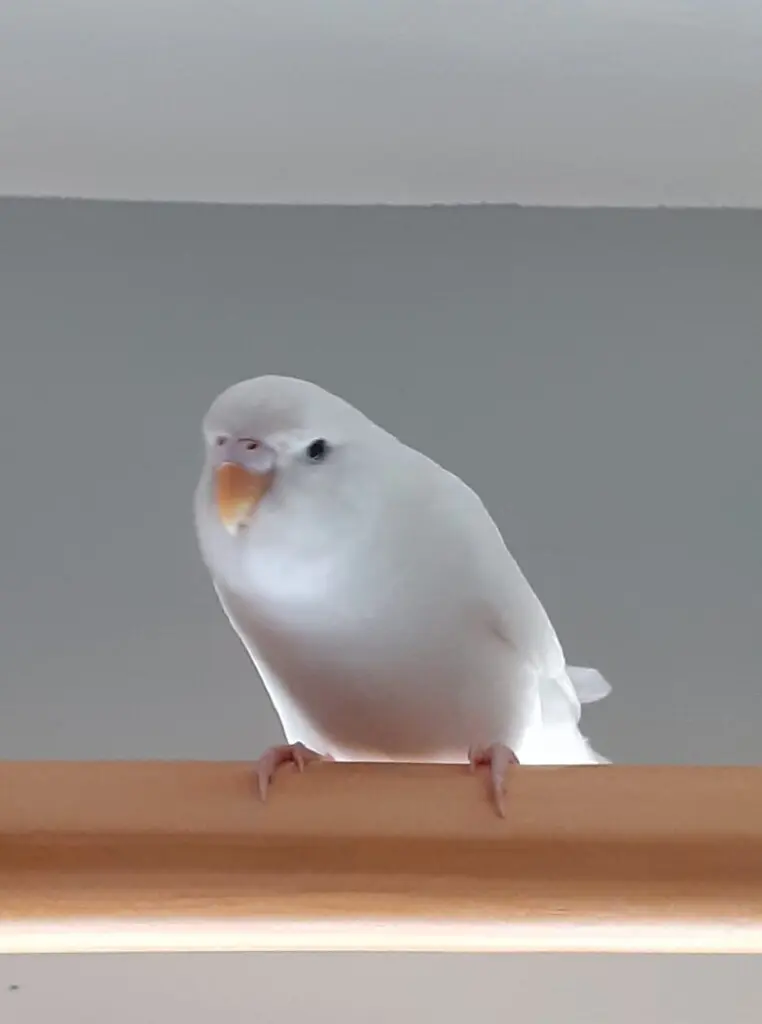
📷 White Budgie Selected Videos
An Albino Budgie Video
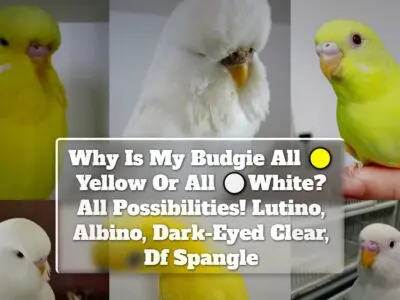
![Half-sider budgies [+WITH EXAMPLES PHOTOS & VIDEOS]](https://www.petiska.com/wp-content/uploads/2022/04/half-sider-budgies-with-examples-photos-videos-1649775303-400x300.jpg)
